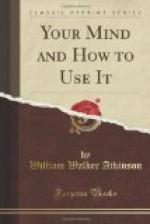A | X / \ B C
Let us suppose that you have already started the new habit, and have said the correct word ten times. That means you have worn another pathway A X C to a considerable depth. During all this time, however, the old pathway is still open and at the slightest provocation will attract the nervous current. Your task is to deepen the new path so that the nervous current will flow into it instead of the old. Now suppose you make an exception on some occasion and allow the nervous current to travel over the old path. This unfortunate exception breaks down the bridge which you had constructed at X from A to C. But this is not the only result. The nervous current, as it revisits the old path, deepens it more than it was before, so the next time a similar situation arises, the current seeks the old path with much greater readiness than before, and vastly more effort is required to overcome it. Some one has likened the effect of these exceptions to that produced when one drops a ball of string that is partially wound. By a single slip, more is undone than can be accomplished in a dozen windings.
The fourth maxim is, seize every opportunity to act upon your resolution. The reason for this will be understood better if you keep in mind the fact, stated before, that nervous currents once started, whether from a sense-organ or from a brain-center, always tend to seek egress in movement. These outgoing nervous currents leave an imprint upon the modifiable nerve tissues as inevitably as do incoming impressions. Therefore, if you wish your resolves to be firmly fixed, you should act upon them speedily and often. “It is not in the moment of their forming, but in the moment of their producing motor effects, that resolves and aspirations




